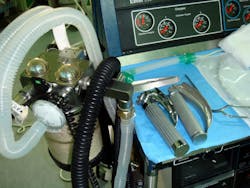New Research Suggests Higher Supplemental Oxygenation Levels for COVID-19 Patients Are Not Always Better
A new study published in JAMA on March 19 suggests that “higher is not better when it comes to targets for supplemental oxygenation levels for COVID-19 patients experiencing low oxygen.”
The study included 726 adults with COVID-19 “receiving at least 10 liters per minute (L/min) of oxygen or mechanical ventilation in 11 ICUs in Europe from August 2020 to March 2023.” The main outcome being studied was number of days alive without life support, and the researchers looked at “Pao2, the partial pressure of oxygen in the arterial blood, at supplemental levels of 60 and 90 millimeters of mercury (mm Hg).”
Patients were randomized “to receive either 60 mm Hg (lower-oxygenation group) or 90 mm Hg (higher-oxygenation group) and followed for 90 days.” At the 90-day mark, “the median time alive without life support was 80.0 days in the lower-oxygenation group and 72.0 days in the higher-oxygenation group. Death rate at 90 days was 30.2% in the lower-oxygenation group and 34.7% in the higher-oxygenation group.”
Richard M. Schwartzstein, MD, of Harvard Medical School, wrote that these findings could possibly be explained by several factors, including that “more patients in the high-target group could have been intubated and started on mechanical ventilation because physicians could not achieve the target with noninvasive ventilation.” He also suggests that “high oxygen targets help patients in some ways, but may also cause inflammation, bronchial epithelial injury, and disruption of mitochondrial respiration in ICU patients.” In addition, he writes that this is another data point suggesting that “use of supplement oxygen to achieve oxygen saturation of the blood beyond 90% to 93%” has “no clinical benefit” and could even harm patients.
CIDRAP’s website has the news release.

